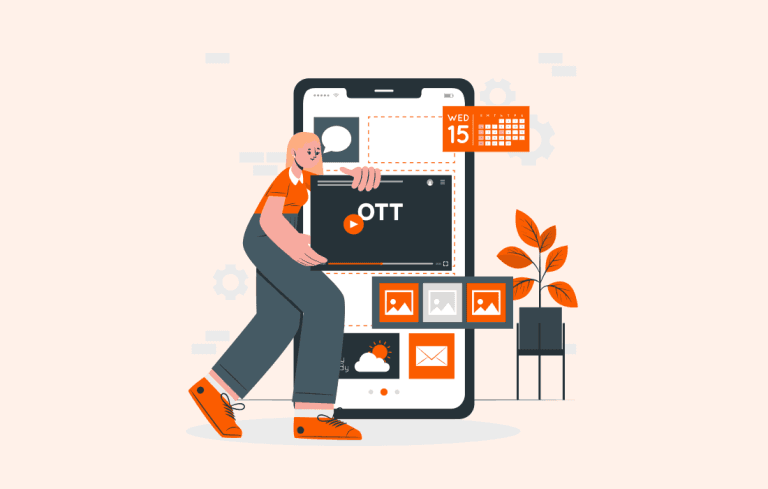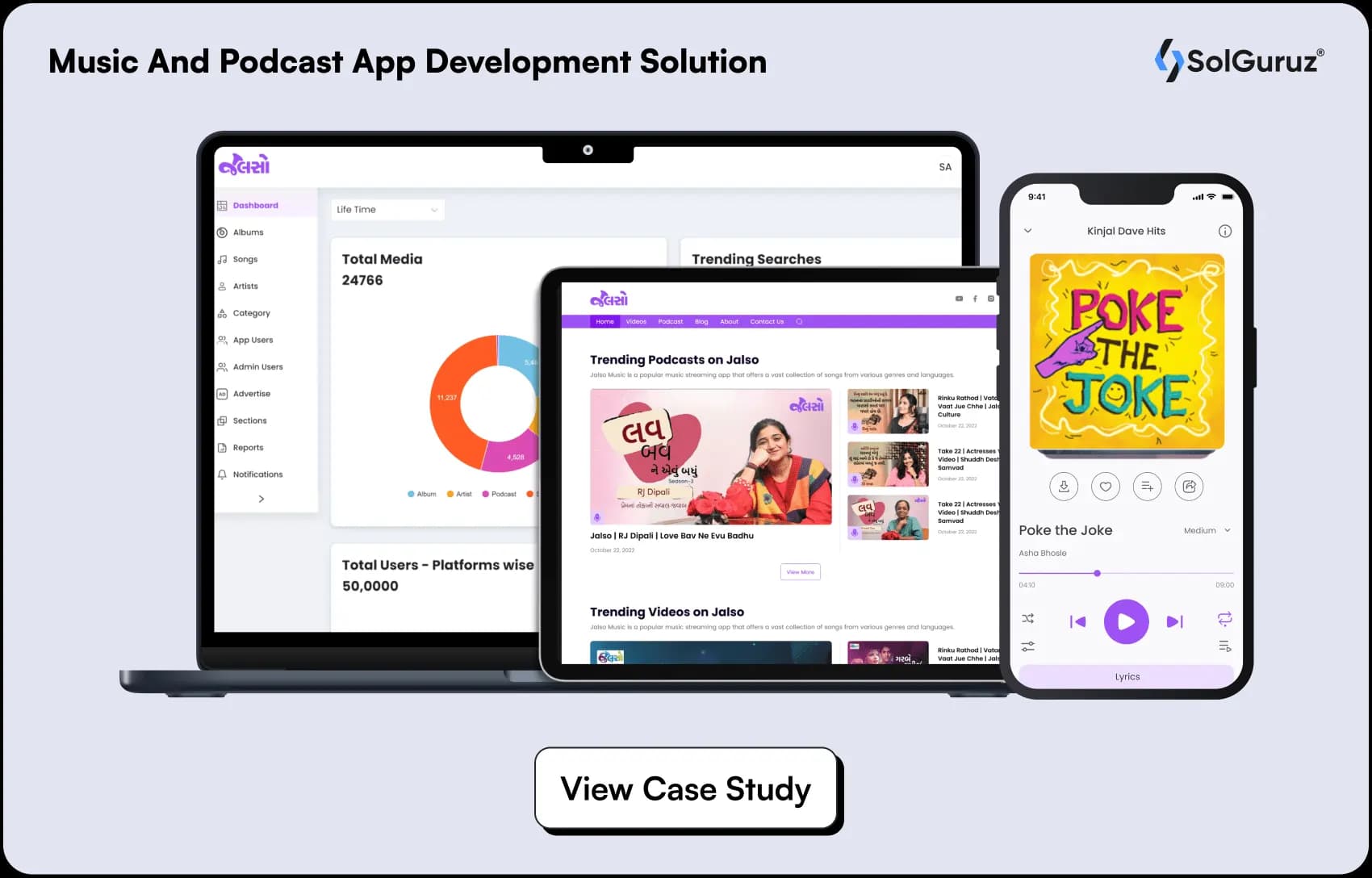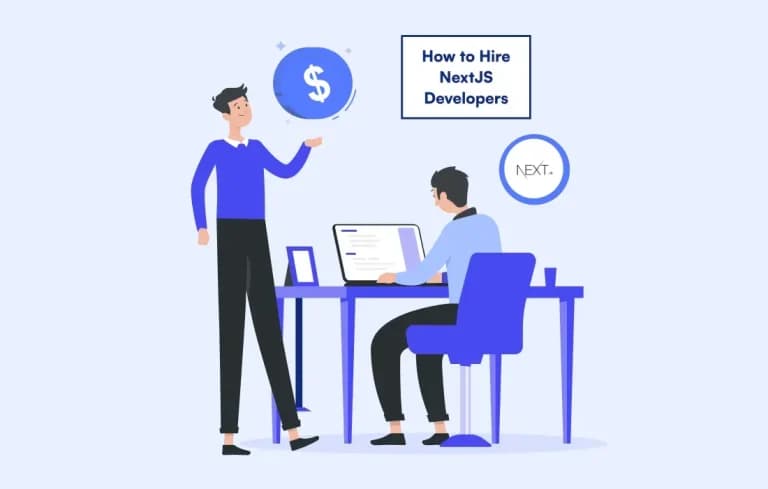Mastering OTT Video App Development: Your Comprehensive Guide
Discover the roadmap to creating an OTT app that attracts and retains users. Your journey to mastering OTT video app development begins here.

OTT video app development has propelled the digital revolution, giving rise to a shift in content consumption and pushing Over-the-Top (OTT) video apps towards a path of massive growth. As traditional broadcasting channels become a thing of the past, OTT platforms lead to exceptional convenience.
Statista’s report projects OTT video sector revenue will grow to USD 316.10 billion by 2023. Furthermore, between 2023 and 2027, the market anticipates a Compound Annual Growth Rate (CAGR) of 10.01%, underscoring the segment’s thriving momentum.
These apps offer users a rich repository of content accessible anytime, anywhere. Now is a great time for businesses and content creators to make their mark in this booming market. To leverage this trend to your benefit, having the appropriate insights and resources is crucial.
Our comprehensive guide to OTT video app development is all about that. So, let’s jump straight into it!
Table of Contents
What is an OTT Platform? Understanding the OTT Marketplace
Moving away from conventional broadcast or cable television, OTT services provide content straight to the audience through internet connectivity. Some key players in this segment include Netflix, Amazon Prime, and Hulu.
Viewers’ demands for flexibility and personalization drive the OTT marketplace. Users now have the flexibility to decide the time, place, and manner in which they enjoy their preferred shows and movies, frequently devoid of advertisements. By 2027, the global user base of OTT platforms is anticipated to skyrocket to an impressive 4.22 billion.
Competition in this space is intense as new players continuously enter the scene and existing ones progress to meet changing consumer tastes. Therefore, it’s important to understand user preferences, technological advances, and monetization strategies before exploring or investing in OTT video app development.
Benefits of OTT Video App Development
OTT (Over-the-Top) video apps stand out as one of the game changers in the media and entertainment sectors. Let’s discuss the benefits of these apps:
1. Global Reach
Unlike traditional broadcasting methods, which may have geographical or regional limitations, OTT video apps have a reach beyond borders. With connectivity to the web, individuals from almost any geographical location can retrieve information.
The valuation of the OTT video streaming market in India is projected to be 5 billion USD by 2023.
2. Increased Earning
The direct-to-consumer model of OTT platforms means that content creators often bypass intermediaries. This leads to higher margins and allows creators to monetize their content through subscriptions, advertisements, or pay-per-view models. OTT platforms witnessed an ARPU of $83.57 in 2022, with forecasts indicating a potential increase to $90.14 in 2023.
3. Rapid Deployment and Scalability
Launching a traditional TV channel or show can be time-consuming and expensive. In contrast, OTT platforms enable quick content deployment. Moreover, the cloud infrastructure behind many OTT video app development services ensures they can scale seamlessly.
4. Advanced Analytics and User Insights
OTT platforms boast state-of-the-art analytics capabilities. These give content creators and marketers detailed insights into user behavior, viewing patterns, and preferences.
5. Multi-Device Support
Nowadays, consumers engage with content through a variety of devices, including smartphones, tablets, smart TVs, and desktop computers. OTT video apps are designed for compatibility across these devices, ensuring a consistent viewing experience.
6. Personalized User Experiences
Studies indicate that a poor first experience will deter 60% of users from using an app. 80% choose to uninstall if faced with recurring issues. This underlines the critical role of a bespoke user experience, beginning with the first touchpoint.
The cherry on top? OTT platforms center around personalization. These platforms can suggest content tailored to individual preferences using algorithms and user behavior data.
Pre-Planning Phase
OTT video app development involves extensive planning and precise execution. Let’s explore these key aspects of the pre-planning phase:
1. Define Your Niche
Your niche is the specific market segment you aim to serve. To determine it, research your target audience’s preferences and the existing competition in the OTT space. Pinpointing your niche will guide the subsequent OTT platform development processes, including content curation and feature integration.
2. Defining Your Value Proposition
As of 2023, the U.S. has over 300 OTT platforms, while India hosts approximately 46 OTT service providers.
A value proposition offers a clear explanation of how your app intends to address a particular challenge or fulfill a certain requirement of your prospective users. It should illustrate why consumers would choose your OTT app over others. It hinges on your unique selling points, which set your app apart from the competition.
3. Understanding Legal Compliances and Regulations
OTT video app development is not just about technology and content. It is equally crucial to adhere to the industry’s prevailing legal compliance and regulations. This includes safeguarding user data, complying with content rights, and meeting regional broadcasting rules.
4. Budget and Financial Planning
Lastly, opt for a realistic OTT video app development project budget. Consider all potential expenses, including platform development, content acquisition, marketing, and operational costs.
Choosing the Right Technology Stack
Selecting an appropriate technology stack is crucial for building robust, scalable, and efficient applications. Let’s get into the fundamental components to consider:
1. Backend Development
The backbone of any application, backend development handles the logic, data operations, and server-side functionalities. Popular choices include:
- Node.js: Perfect for data-intensive apps.
- Ruby on Rails: Developer-friendly environment.
- Django (Python): Robust and secured.
2. Frontend Development
The front end concentrates on visual appeal and user interactions. It shapes the overall user experience. Choosing the right front end technology is essential to building a responsive and attractive user interface. Some key options are:
- React: Best for building UI components.
- Vue.js: Noted for its uncomplicated nature and reliability.
- Angular: Perfect for developing grand-scale applications.
3. Databases
Databases store, retrieve and manage data for your application. The choice of database impacts your application’s performance, scalability, and reliability.
- Relational Databases (RDBMS) like MySQL or PostgreSQL: Best suited for structured data and sophisticated queries.
- NoSQL Databases like MongoDB: Suitable for flexible schemes and rapid application needs.
4. Streaming Protocols
Selecting the right protocol for applications focusing on video or audio streaming ensures quality and real-time data transmission.
- HLS (HTTP Live Streaming): Streams content efficiently.
- DASH (Dynamic Adaptive Streaming over HTTP): A protocol for high-quality playback.
5. DRM and Security Protocols
Protecting content and user data is paramount. Implementing robust Digital Rights Management (DRM) and security protocols safeguards against breaches and unauthorized access.
- Widevine & FairPlay: Widely accepted DRM systems.
- SSL/TLS: Encrypt the data transmitted between users and servers for secured communication.
Designing the OTT Video App
Building a successful OTT video app combines aesthetics, functionality, and user-centric design. Here’s a guide to key design elements to consider:
1. User Interface (UI) Design
Investing a single dollar in UX design can yield a substantial return of a hundred dollars, representing a remarkable 9,900% ROI. Despite this potential, 70% of online enterprises fail due to subpar UX.
User Experience Fundamentals: The essence of a captivating OTT app lies in its user experience. Navigation should be intuitive, with content categorized logically.
Accessibility: Ensuring accessibility for all users, especially those with disabilities, is vital when designing your app. Incorporate high-contrast color schemes, integrate voice-over capabilities, and optimize for screen reader compatibility.
2. Features and Functionalities
User Profiles: Personalization is at the heart of OTT platforms. Allow users to create profiles to offer curated content recommendations, remember playback positions, and customize user settings.
Search and Recommendation Engines: Efficient search functionality with auto-suggestions ensures users find content effortlessly. Further, leveraging AI for recommendations can offer users a range based on their viewing history and preferences.
Content Management System (CMS): A robust CMS is essential for OTT platforms. It allows content upload, categorization, and management.
Payment Gateways: Ensure multiple payment options for user convenience and use encrypted protocols for secure transactions, especially for premium content or subscription models.
3. Responsive Design
Mobile Responsiveness: With users accessing content on various devices, ensuring your OTT app is mobile-responsive is paramount. Design elements should adapt and resize based on the device.
Platform Compatibility: OTT apps often need to function across various platforms, including iOS, Android, web browsers, and smart TVs. Designing with platform compatibility in mind ensures a consistent and glitch-free user experience across devices.
Development Phase
Building an OTT video app demands precision, adaptability, and a robust approach to cater to the dynamic needs of digital audiences. Here’s a breakdown of the crucial steps involved in this development phase:
1. Agile Methodology for OTT App Development
Adopting the Agile methodology ensures flexibility and a faster response to changing requirements. Agile allows for continuous feedback, iterative development, and regular software releases. This strategy guarantees that the product stays pertinent, focused on the user, and flexible throughout its development process.
2. Building MVP (Minimum Viable Product)
Before getting into full-fledged OTT app development, testing the waters with a Minimum Viable Product (MVP) version is wise. This stripped-down version of your OTT app focuses on core functionalities. It allows you to gauge user reactions and gather feedback. With an MVP, you can validate your app idea, assess market viability, and make informed decisions for subsequent OTT application development phases.
3. Integration with Third-party Services
OTT video apps often require integrations with various third-party services for functionalities like payment gateways, analytics, content distribution, and more. This step ensures that your app seamlessly interacts with these external services.
4. Backend and Server Development
The backbone of your OTT app, the backend, ensures everything runs smoothly behind the scenes. This step encompasses setting up servers, databases, and APIs, ensuring they communicate effectively. Backend development focuses on:
- Server setup: Establishing a robust server infrastructure to handle vast data and high user traffic.
- Database management: Storing user profiles, video metadata, viewing history, etc. in a structured and secure manner.
- API development: Facilitating communication between the app, database, and other integrated services.
Testing Phase
After the OTT video app development phase, it’s time to ensure a glitch-free and smooth user experience. Testing your application is an integral step in achieving this objective. Here’s an overview of this pivotal phase:
1. Types of Testing
There are multiple types of testing, including:
- Functional Testing: Functional tests ensure that all features, from user registration to video streaming, work seamlessly.
- Performance Testing: Performance tests gauge the app’s response time, reliability, and stability under varying conditions.
- Security Testing: Security tests evaluate the app’s resilience against potential threats, unauthorized access, and vulnerabilities.
2. Beta Testing: Feedback Collection & Improvements
Beta testing involves launching the app to a small, targeted group to accumulate real-user experiences and responses. This phase is instrumental in identifying unseen issues and understanding user preferences. Feedback from beta users provides invaluable insights. It leads to refinements in the user interface, content curation, or even feature enhancements.
3. Pre-launch Testing
Before the grand release, the app undergoes a comprehensive final check. This encompasses all previous tests but in a more integrated manner. The idea is to simulate real-world scenarios and stresses the app might face post-launch, ensuring it is market-ready and free from critical bugs.
Launch Phase
The launch phase is a critical moment in the lifecycle of an OTT video app. It sets the stage for user reception and initial traction. Here’s a breakdown of the essential steps in this phase:
1. Launch Strategy
A meticulously planned strategy backs every successful product launch. An OTT video app should focus on target audience identification, promotional campaigns, and collaborations. Decide on a soft launch for a limited audience or a grand launch—partner with content creators or influencers to amplify the reach.
2. App Store Optimization (ASO)
Visibility in app stores directly influences downloads. ASO (App Store Optimisation) is to apps what SEO is to websites. Create an engaging description with relevant keywords. High-quality screenshots and video previews can showcase app functionality. Collect and showcase positive reviews and monitor the app’s rating.
3. Launch on Various Platforms: Android, iOS, and Web
Diversifying your presence can maximize reach:
- Android: Deploy your app on the Google Play Store. Considering the vast user base, ensure the app is optimized for Android devices and screen sizes.
- iOS: Launch on Apple’s App Store. Adherence to Apple’s stringent guidelines is crucial to ensure a smooth user experience for iPhone and iPad users.
- Web: A web version of the app caters to users on laptops and desktops. This can be a responsive website or a web app, offering similar functionalities as mobile versions.
Post-launch Management
After the launch of an OTT video app, the journey is far from over. The post-launch phase is about retaining users, ensuring consistent performance, and adapting to evolving needs. Here’s a detailed overview:
1. Content Management
The core of any OTT platform is its content. Updating the library with fresh, relevant, and diverse content keeps users engaged. It’s also essential to categorize and organize content efficiently. Collaborations with content creators, purchasing rights for exclusive shows, or even producing original content can set the platform apart.
2. Community Engagement and Customer Support
Building a community around the app enhances user loyalty. Engage users through forums, social media, and feedback platforms. Interacting with the audience provides insights into their preferences and grievances. An efficient customer support system ensures that you address users’ issues. It enhances satisfaction and trust.
3. Analytical Tools for Performance Monitoring
Using analytical tools helps monitor app performance, track user behavior, and gauge content popularity. Tools like Google Analytics or in-built analytics dashboards can provide metrics on user retention, average viewing time, and peak usage hours.
4. Updates and Maintenance
Technology and user needs evolve. Regular app updates addressing bugs, introducing new features, or improving the user interface are crucial. Scheduled maintenance ensures the backend runs smoothly by reducing downtime or glitches.
With SolGuruz, Create OTT Apps Tailored to Perfection
Choosing SolGuruz for your OTT app development comes with a promise of perfection and a commitment to innovation.
We mix technology with creativity to build apps and experiences that captivate viewers and foster loyalty.
We prioritize your vision and work closely with you at every step to develop an app that truly reflects your brand’s essence, all while offering features at the forefront of technology.
Why is SolGuruz the ideal partner for your OTT app development project?
- Proven Track Record: With over 40 successful product launches in just three years, our experience speaks volumes.
- Stellar Growth: Our growth rate of 81% since 2022 stands as a testament to our dynamic, forward-thinking approach.
- Trusted by Peers: Our clients’ faith in us is reflected in the fact that 70% of our new projects come through referrals.
- Tailor-Made Solutions: We don’t believe in one-size-fits-all. We create solutions uniquely tailored to meet your brand’s objectives and vision.
- Industry Innovators: By choosing SolGuruz, you are opting for a partner to help you with futuristic solutions.
With SolGuruz, you choose supreme expertise and a journey tailored to perfection.
Conclusion
OTT Video App Development is a journey that combines technological expertise with a deep understanding of modern viewership trends. As digital consumption patterns change, OTT streaming platforms emerge as the front-runners in redefining entertainment.
From the initial phases of understanding the marketplace and selecting the right technology stack to meticulous OTT software development and testing, each step is important for a successful launch.
Yet, the journey doesn’t end at the launch. It extends into post-launch management, where continuous engagement, updates, and content dynamism come into play. With a holistic approach to OTT app development, businesses can penetrate this market and offer viewers a seamless, personalized, and immersive viewing experience.
FAQs
1. What are OTT apps, and how does it differ from traditional app development?
OTT video app development aims to distribute video content via the internet, eliminating the need for traditional broadcast mediums. It involves specialized features like streaming, content management, and playback controls.
2. How does the development process for OTT apps cater to different platforms like smart TVs, gaming consoles, and mobile devices?
Development for OTT apps on varied platforms requires tailored user interfaces, optimization for device-specific hardware, and compatibility considerations to ensure seamless video playback across devices.
3. What are the essential features every OTT video app should possess to ensure a competitive edge in the market?
Essential features for a competitive OTT video app include a user-friendly interface, personalized content recommendations, multi-device support, offline viewing, and robust search capabilities.
4. How can I ensure the highest quality video streaming for users across various internet bandwidths?
For optimal video streaming across varied bandwidths, implement adaptive bitrate streaming (ABR). This adjusts video quality in real time based on the user’s internet speed, ensuring smooth playback.
5. What measures should be taken during OTT app development to secure content and protect against piracy?
To secure content in OTT apps, utilize Digital Rights Management (DRM) systems, enforce strong encryption standards, and frequently update security protocols to protect against emerging threats.
6. How do you integrate monetization strategies, like subscription models or advertising, into OTT video app development?
Integrate in-app purchase capabilities for subscription models and embed video ad platforms for ad-based revenue. Ensure a seamless user experience around these monetization methods.
7. Can OTT apps be developed to support live streaming, and what additional considerations does this entail?
Yes, OTT apps can support live streaming. This involves real-time content delivery, requiring robust backend infrastructure, low-latency streaming protocols, and capabilities to handle large simultaneous viewer numbers.
Build Your OTT App
Enter the streaming market with a compelling OTT video app. SolGuruz provides end-to-end development services for a seamless launch.

Strict NDA

Trusted by Startups & Enterprises Worldwide

Flexible Engagement Models

1 Week Risk-Free Trial
Give us a call now!

+1 (724) 577-7737



